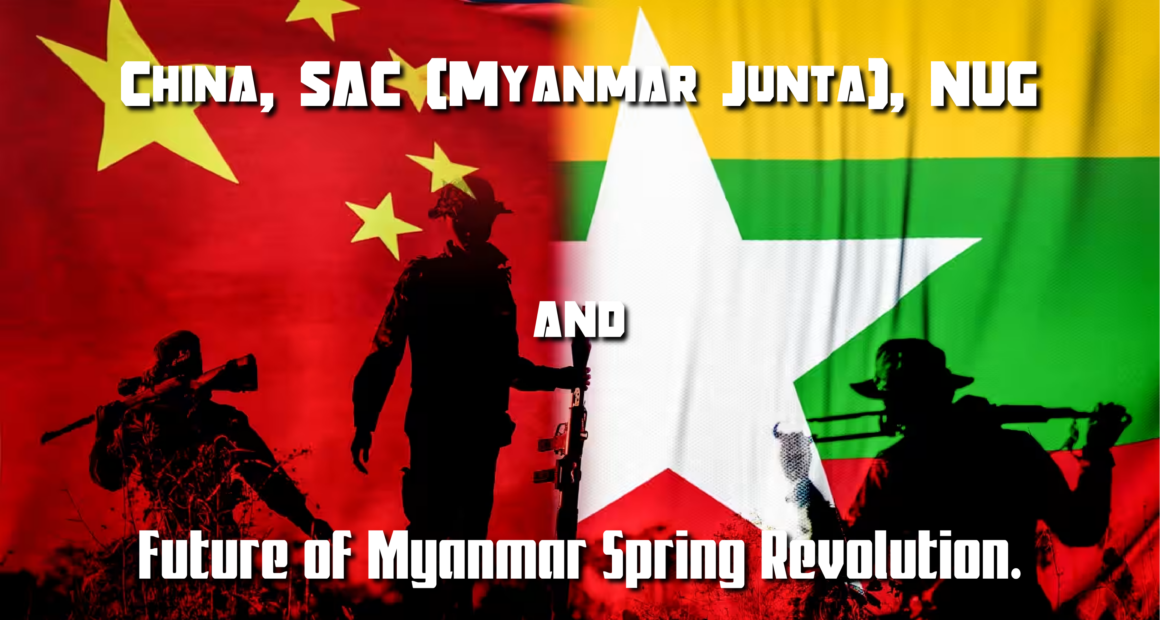The future of Myanmar’s Spring Revolution, which erupted following the military coup in February 2021, is shaped by a complex interplay of internal dynamics and external factors. Here’s a comprehensive analysis of the situation:
1. Background and Context
- The coup ousted the democratically elected government of Aung San Suu Kyi and the National League for Democracy (NLD).
- Widespread protests and civil disobedience movements emerged, leading to a nationwide uprising against the military junta, known as the State Administration Council (SAC).
- Ethnic armed groups and newly formed resistance groups, including the People’s Defense Forces (PDF), have engaged in armed conflict against the military.
2. Current Dynamics
- Resistance Movements: The PDF and various ethnic armed organizations have increased their military capabilities, challenging the junta’s control over several regions. The conflict has led to significant civilian casualties and displacement.
- Civil Disobedience: Non-violent protests and strikes continue in urban areas, despite increasing repression. Many professionals, including healthcare workers and educators, have participated in the civil disobedience movement, undermining the military’s governance.
- Humanitarian Crisis: The conflict has precipitated a severe humanitarian crisis, with millions displaced and access to basic services severely hindered. International organizations are struggling to provide aid amid ongoing violence.
3. Political Landscape
- Fragmentation of Opposition: The opposition is not unified, with differing visions for Myanmar’s future, including federalism versus centralism, and varying degrees of engagement with armed resistance.
- Role of the NLD: The NLD remains a significant player, but its leadership is either in hiding or detained, complicating efforts to coordinate a unified front.
- Ethnic Politics: Ethnic minority groups have gained prominence in the resistance, advocating for greater autonomy and inclusion in any future political framework.
4. International Response
- Sanctions and Diplomacy: Western nations have imposed sanctions on the junta, but the effectiveness of these measures is debated. ASEAN has attempted to mediate but has faced criticism for its lack of concrete actions.
- Geopolitical Considerations: The interests of regional powers, particularly China and India, influence the situation. China’s support for the junta complicates efforts for international consensus, while India’s border security concerns drive its cautious engagement.
5. Future Scenarios
- Continued Conflict: If the military remains entrenched and refuses dialogue, prolonged conflict is likely, leading to further humanitarian crises and regional instability.
- Negotiated Settlement: A potential pathway involves international mediation leading to negotiations between the junta and opposition groups, possibly resulting in a power-sharing agreement or a transition to federalism.
- Emergence of a New Government: A significant defeat of the military, through sustained resistance efforts, could lead to the establishment of a new government reflective of the popular will, though this scenario would require immense sacrifice and unity among opposition factions.
6. Societal Impact
- Social Cohesion: The revolution has fostered a sense of nationalism among diverse ethnic groups, potentially paving the way for a more inclusive society if a democratic government is restored.
- Youth Engagement: The involvement of youth in the revolution has shifted social dynamics, with a new generation advocating for democracy, rights, and political participation.
Relationship Between China, SAC (Myanmar Junta), NUG
The relationship between China, the State Administration Council (SAC) of Myanmar, and the National Unity Government (NUG) is complex and reflects the shifting political landscape in Myanmar following the 2021 coup. Here’s a detailed analysis:
1. Background Context
- State Administration Council (SAC): The SAC, led by the military (Tatmadaw), took power following the coup, overthrowing the democratically elected NLD government. The junta has sought to consolidate power amid widespread protests and armed resistance.
- National Unity Government (NUG): The NUG was formed by ousted lawmakers and representatives of various ethnic groups, aiming to establish a federal democratic government and gain international recognition.
2. China’s Relationship with the SAC
- Support and Legitimacy: China has maintained a relationship with the SAC, viewing it as the legitimate governing body in Myanmar. This aligns with China’s principle of non-interference in the internal affairs of sovereign nations.
- Strategic Interests: China has economic and strategic interests in Myanmar, including infrastructure projects linked to the Belt and Road Initiative (BRI). A stable government, even if it’s a junta, is essential for China’s investments.
- Military Cooperation: Reports suggest that China has provided military supplies and support to the SAC, reflecting its interest in maintaining a stable regime that can control border areas and prevent instability that might affect China.
3. China’s Position on the NUG
- Cautious Engagement: China has been cautious in its engagement with the NUG. While it has not openly recognized the NUG, it has maintained informal contacts, reflecting a pragmatic approach.
- Ethnic Considerations: Given that the NUG includes representatives from various ethnic groups, China may see value in engaging with it to ensure stability among these groups, especially if they pose challenges to its interests.
4. Balancing Act
- Pragmatism: China seeks to balance its relationship with both the SAC and the NUG. While it officially supports the junta, it recognizes that the NUG represents a significant portion of the population and has potential influence over the future political landscape.
- Regional Stability: China’s primary concern is stability along its border with Myanmar. Instability can lead to spillover effects, including refugee flows and increased cross-border insurgency, which China aims to mitigate.
5. Implications of the Coup
- Shift in Dynamics: The military coup has complicated China’s strategic calculations. The junta’s increasing isolation and the NUG’s growing legitimacy among opposition groups may lead China to reassess its approach.
- Economic Dependencies: The junta’s reliance on Chinese investments for economic stability may create leverage for China, allowing it to influence SAC policies.
6. Future Considerations
- Evolving Relationships: As the conflict in Myanmar continues, the dynamics between these actors may evolve. If the NUG gains more support, China might consider a more nuanced approach to engage with them to maintain influence.
- Impact on Regional Politics: The relationship between China and these two factions could have broader implications for regional stability and influence, particularly concerning ASEAN and other neighboring countries.
Relationship Between China and Ethnic Armed Organizations (EAOs) in Myanmar
The relationship between China and ethnic armed groups (EAGs) in Myanmar is intricate and shaped by a variety of historical, political, and economic factors. Here’s an overview:
1. Historical Background
- Ethnic Diversity: Myanmar is home to numerous ethnic groups, many of which have formed armed organizations to assert their rights and autonomy. This includes groups like the Kachin Independence Army (KIA), the Arakan Army (AA), and the Shan State Army (SSA).
- Geopolitical Context: China’s proximity to Myanmar and its interests in border stability have historically driven its engagement with EAGs.
2. China’s Engagement Strategies
- Diplomatic Relations: China has maintained relations with various EAGs to ensure stability along its border and to safeguard its economic investments in Myanmar.
- Mediation Role: China has positioned itself as a mediator in peace negotiations between the Myanmar government and EAGs, promoting dialogues aimed at achieving lasting peace.
3. Economic Interests
- Infrastructure Investments: China’s investments in infrastructure projects, such as roads and pipelines, necessitate a stable environment in areas controlled by EAGs. Therefore, China often engages with these groups to secure access to resources and trade routes.
- Resource Extraction: Some EAGs control valuable natural resources. China’s engagement with these groups can be motivated by its need for raw materials and energy security.
4. Military and Security Dynamics
- Arms Supplies: While reports suggest that China has provided military support to certain EAGs, such relationships are often clandestine. This military cooperation is typically aimed at maintaining a balance of power and ensuring the stability of border regions.
- Counterinsurgency Cooperation: China has expressed concerns about cross-border insurgency and may support Myanmar’s military to prevent spillover effects, balancing this with its ties to EAGs.
5. Impact of the Military Coup (2021)
- Changing Relationships: The coup has complicated the dynamics between the military, EAGs, and China. Many EAGs have intensified their opposition to the military, which may lead to shifting alliances with China as they seek to assert their political relevance.
- Increased Autonomy Aspirations: Some EAGs view China as a potential ally against the junta, aiming to leverage their relationships to gain more autonomy or recognition.
6. Regional and Geopolitical Implications
- Belt and Road Initiative (BRI): China’s involvement in Myanmar is part of its broader BRI strategy. EAGs play a crucial role in ensuring the success of projects that traverse ethnic regions.
- Influence on Neighboring Countries: China’s relationships with EAGs can affect regional stability, influencing relations with countries like India and Thailand, which share concerns about cross-border dynamics and security.
Conclusion
The future of Myanmar’s Spring Revolution is uncertain, hinging on the ability of opposition forces to maintain momentum, the junta’s willingness to engage in dialogue, and the role of international actors. The struggle for democracy in Myanmar may continue for years, with significant implications for regional stability and human rights. A resolution will require not only addressing immediate political grievances but also laying the groundwork for long-term reconciliation and governance that respects the rights and aspirations of all Myanmar’s people.
China’s relationships with the SAC and the NUG are shaped by a pragmatic approach focused on stability and its economic interests in Myanmar. While it officially supports the junta, China is aware of the NUG’s role and the changing political landscape. The future of these relationships will depend on the evolving dynamics of the conflict and the broader geopolitical context in Southeast Asia.
The relationship between China and ethnic armed groups in Myanmar is multifaceted, driven by a mix of economic interests, security concerns, and geopolitical strategies. As the political landscape in Myanmar evolves, particularly following the military coup, these relationships may shift further, impacting both local dynamics and broader regional stability. EAGs will continue to navigate their relationships with China while pursuing their goals for autonomy and representation within Myanmar.








